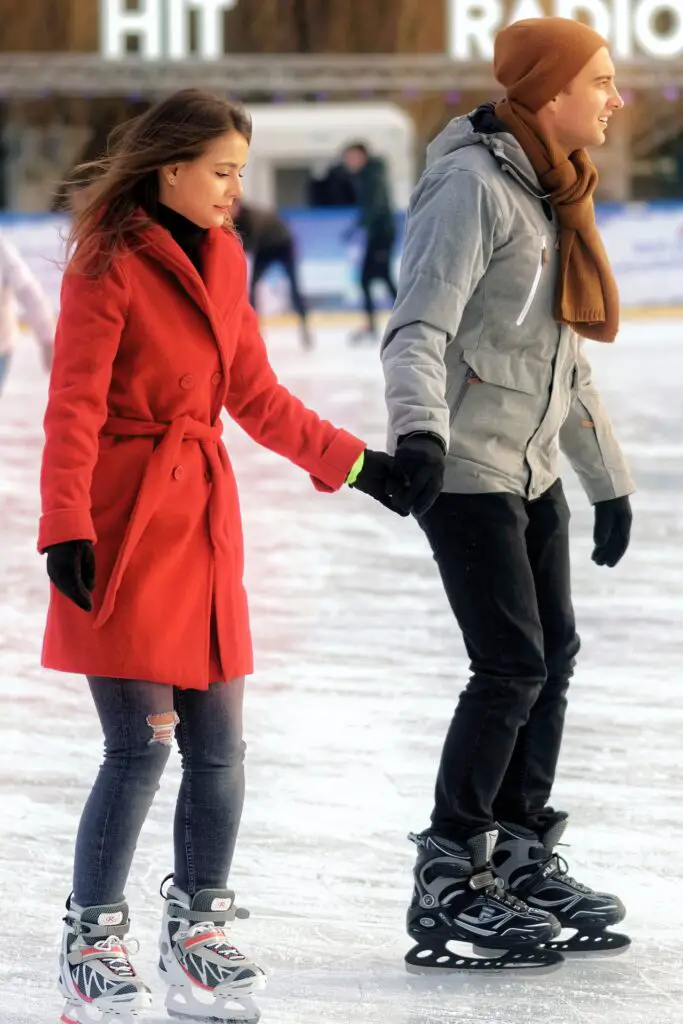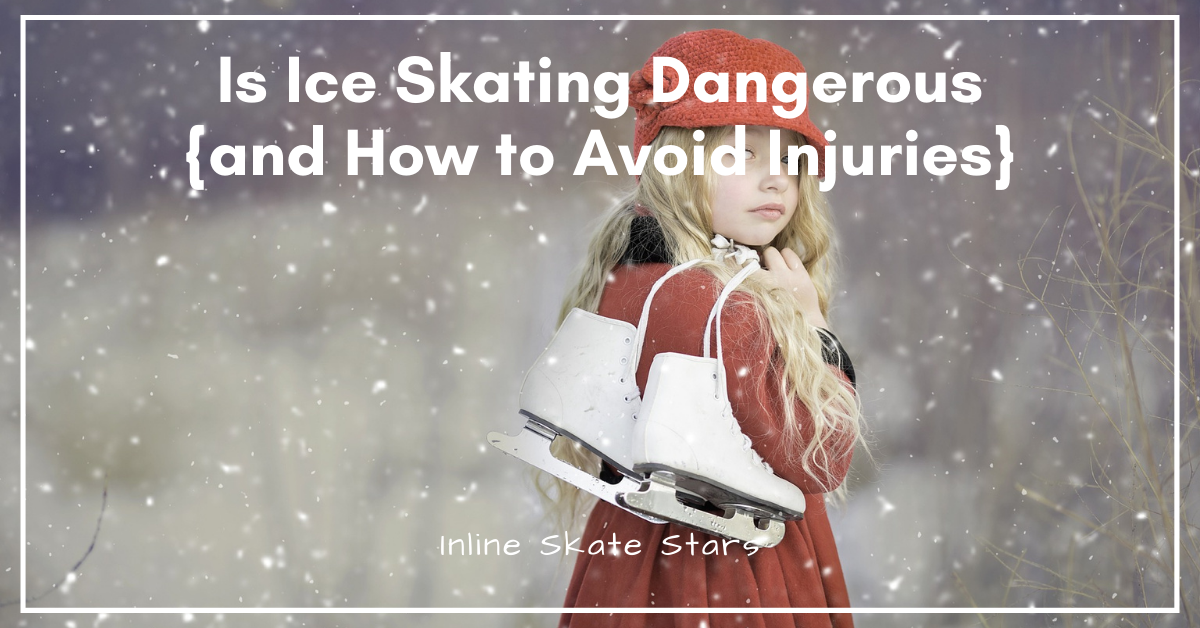Is ice skating dangerous? Whether you’re into figure skating, hockey ice skating, or recreational ice skating, ice skating can be a little dangerous. Ice skating is associated with dangers like falling on ice-cold hard surfaces, collision in crowded rinks, ponds, rivers, or lakes caving in, ill-fitting ice skates, and over skating that hurts muscles.
Nonetheless, you can minimize the dangers associated with ice skating when you take the necessary precaution, as we’ll see in a minute. I’ve put this piece together from experience and research. So you can rest assured it’s the best information out there.
That being said, let’s jump right into it!
Is Ice Skating Dangerous? Risks Associated with Ice Skating
Ice skating can be a little dangerous depending on what goes on at the ice skating rink, the type of ice skating gear you use, and your ice skating techniques. Below are the risks associated with ice skating that you should look out for to prevent unnecessary injuries.
Related post: Rollerblading Vs. Ice Skating | the Ultimate Comparison
1. Falling on Ice-cold Hard Surfaces
Falls are inevitable when ice skating, regardless of your ice skating skills level. However, beginners are more susceptible to falling and may suffer severe injuries than experienced ice skaters.
That being said, experienced skaters mostly fall when skating at high speed and get tripped along the way. While some skaters can control the fall to land safely, unfortunately, others miss it and eventually getting hurt in the process.
Also, the ice rinks are made of hard, ice-cold concrete surfaces. This is the main reason falling forward or backward when ice skating can be risky. During a fall, many skaters use their hands to prevent the fall, especially newbie skaters.
It’s important to learn the appropriate fall techniques to prevent hurting your hands. If the fall is hard, you can break or twist your wrists. Also, you can get minor cuts on the hands, which can be quite painful.
Related Post: What to Wear Ice Skating Indoors {10 Essential Wears}
Other dangers associated with falling are head, elbow, knees, and tail bone injuries. Head injuries occur when you fall on your head and suffer a concussion. A severe injury can be disastrous, leading to surgery (hopefully, it doesn’t come to that).
On the other hand, elbow and knee injuries happen when you land on the icy surface on your elbows or knees. Moreover, if you fall backward on your butt, you can break your tail bone, which often hurts badly!
The best way to avoid these fall injuries is to learn how to fall properly. Below is a comprehensive article I did with you in mind. Ice skating is a discipline of inline skating, so you’ll discover all the possible ways for safe falls when skating.
Related post: How to Fall when Rollerblading (4 Incredibly Safe Techniques)
Is Ice Skating Like Rollerblading? | {the Ultimate Comparison}
Please check out these awesome helmets for ice skating on Amazon
OnBros Adult Bike Helmet – Safety Certified
ZIONOR Skateboard Helmet for Kids/Youth/Adults
MONATA Skateboard Bike Helmet for Adults, Youths, and Teens
2. Collision in Crowded Rinks
Many times, the ice skating rinks can be crowded, especially during school holidays and on weekends. So whether you’re doing recreational ice skating or hockey ice skating, you need to be wary of what’s going on at the rinks.
The risk is even more when playing ice hockey, considering it’s a rigorous sport. For example, it’s common to skate back and forth to score or defend when playing ice hockey. Also, during tackles, it’s possible to get into collisions with fellow team members and opponents.
This alone can lead to serious injuries on the head, chest, legs, and the entire body, especially when not wearing the right protective gear. The situation can get worse when you don’t have any protective gear at all.
Getting into collisions when doing recreational ice skating is also common during the holidays and over the weekends. If you’re a newbie or a slightly experienced skater, you want to stay safe by skating away from crowds until you have mastered control while in your ice skates.
Please check out these awesome Jackets for ice skating on Amazon
Amazon Essentials Boys’ Light-Weight Water-Resistant Packable Puffer Jacket
Alpine Swiss Niko Mens Down Alternative Jacket
3. Ponds, Rivers, or Lakes Caving in
Ice skating on natural surfaces like ponds, rivers, or lakes during winter can be fun. Overall, ice skating outdoors is refreshing and pleasurable, but it also possesses unexpected risks. How does this come about, you ask?
The frozen surface may be thin, weak, and can cave in with your weight on top. Also, it may get warmer, causing the ice to melt away. When this happens, you’re likely to pick numerous injuries. First, the ice edges can cut you, and second, you may drown in the lake, river, or pond.
If you’re not sure of the river, lake, or pond status, it’s best to avoid skating on such surfaces for your safety. Nonetheless, assuming it is winter, you can still skate on frozen roads or open spaces in your neighborhood. That would be safer than skating on frozen water bodies.
Please check out these awesome socks for ice skating on Amazon
Mondor Light Opaque Knee High Skating Socks
CRS Cross Figure Skating Socks
4. Ill-fitting Ice Skates
Ill-fitting skates are either too tight or too oversized. Too tight ice skates exert pressure on your feet and ankles and result in ankle and feet injuries. Severe ankle injuries can be costly as they may need surgery to fix the ankles.
Related post: Inline Skates: How to choose Inline Skating Shoes |Beginners and Intermediates
Besides that, when the ice skates are uncomfortable, you may get blisters on your feet after skating for a while. From experience, blisters aren’t cool in any way, and they can affect normal walking because it’s hard-wearing shoes when you have blisters.
Related post: How to Prevent Blisters When Rollerblading |3 Effective Solutions
Moreover, the ice skates shouldn’t be too loose, as that can cause your feet to wobble. This can result in pronation, which can negatively affect your ankles more. While skating, your feet and skates should be parallel to your legs without inclining in or outside.
Unfortunately, wobbling feet don’t allow this. Instead, your feet will incline to the inside, aka pronation or outside (supination). However, it’s probation that’s common among beginner and slightly advanced skaters. If this condition persists, your feet may remain in this stature until corrective surgery is done.
Related Post: How to Keep Ankles Straight When Rollerblading (3 Easy Steps)
Please check out these awesome ice skating shoes on Amazon
Jackson Ultima SoftSkate Womens/Girls Figure Skate
Glacier by Jackson Ultima White Figure Ice Skates for Toddler, Girls, and Women
Riedell Skates – Soar Adult Ice Skates- Recreational Soft Beginner Figure Ice Skates
5. Over-Skating
Ice skating, like every other pleasurable thing, should be done with limits. The sport is fun, and I get it that you want to skate as often as you can. But, unfortunately, that won’t be helpful in the long haul. How’s that so? You’re probably wondering.
Over skating can overstretch your body muscles since the sport works all muscle groups. This affects muscle groups like the core, gluteus, hamstrings, and the adductors muscles, which can experience soreness, cramps, sprains, and tear.
Related post: What Muscles Does Rollerblading Work? The Ultimate Discovery!
Since these muscles have an elastic limit, it’s best not to overstretch them for your good. Therefore, skating once in a while 2-3 times a week goes a long way. Moreover, quality often supersedes quantity, and I’d urge you to go for quality ice skating.
Related post: Shins Hurt when Rollerblading (How to Make it Stop)
Is Ice Skating Hard? (Your Burning Question Answered Comprehensively)
Is Ice Skating Dangerous? Final Thoughts

Ice skating can be dangerous, so if you’re asking the question. Unfortunately, the answer is a yes. Ice skating exposes one to dangers like falling on ice-cold hard rinks, collision in crowded rinks, ponds, rivers, and lakes caving in, ill-fitting ice skates, and soreness in muscles when one over skates.
That being said, the best way to have fun when doing figure skating, recreational skating, or speed skating is to take caution by wearing protective gear like a helmet. In addition, it would be best to avoid crowded rinks, ponds, rivers, and lakes that are likely to cave in.
Lastly, go for the best-fitting ice skates to comfort and protect your ankles and feet from blisters. Yes, ice skating can be dangerous. However, if you practice some little caution, you may not have to stress over the dangers of ice skating.
Related Posts: Can Rollerblading Help My Figure Skating? (5 Effective Ways)
Does Rollerblading Help Skiing? The Ultimate Comparison
How Many Calories Do I burn Ice Skating? {640-850}


